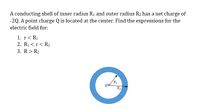Question

Transcribed Image Text:A conducting shell of inner radius R1 and outer radius R2 has a net charge of
-2Q. A point charge Q is located at the center. Find the expressions for the
electric field for:
1. r< R1
2. R1 <r< R2
3. R> R2
R1
R2
Expert Solution
This question has been solved!
Explore an expertly crafted, step-by-step solution for a thorough understanding of key concepts.
Step by stepSolved in 2 steps

Knowledge Booster
Similar questions
- A particle of charge 2.0 x 10-8 C experiences an upward force of magnitude 1.5 x 10-6 N when it is placed at a particular point in space. Hint a. What is the electric field at that point? The electric field at that point is N/C. b. If a charge q = The force is in Select an answer direction with magnitude (Use "E notation" to give your answer in scientific notation, e.g. "3.14E-12" for 3.14 x 10-12 .) 3.0 x 107 -8 C is placed there, what is the force on it? Question Help: Message instructor Submit Question Course Chat N. MacBoarrow_forward1. a nonconducting rod of length L has charge -q uniformly distributed along its length. (a) What is the linear charge density of the rod? (b) What is the electric field at point P, a distance a from the end of the rod? (c) If P were very far from the rod compared to L, the rod would look like a point charge. Show that your answer to (b) reduces to the electric field of a point charge for a >> L.arrow_forwardA hollow conducting sphere has an inside radius of r1 = 0.17 m and an exterior radius of r2 = 0.27 m. The sphere has a net charge of Q = 5.4E-06 C. What is the field E1 in N/C 1 m from the sphere's exterior surface? What is the magnitude of the field at a distance of 0.05 m from the center of the sphere?arrow_forward
- For each charge distribution: -6.0 x 10-5 C 4.0 x 10-5 C 2.0 m 9₁ L. - 6.0 x 10-5 C 3.0 m A q2 2.0 m A 3.0 m 2 - 3.0 x 10-5 C 1. 2. a. Determine the net electric field at point A for the following charge distribution. b. The magnitude of the electric field due to each charge, (i.e. calculate ε₁ and ε2), at point A. c. The net electric field at point A. a. For each part in practice question 1, find the net force on a -1.2 × 10-5 C charge placed at point A. b. How would your answer change if the sign of the charge from 2a at point A was changed? 3. Explain why the concept of a field was used to describe the force of gravity between two masses. 4. Give two reasons why the concept of a field is used again to describe the force between two charged objects.arrow_forwardA thin, insulating rod of length Icarries a linear charge density^(x) that varies with distance according to (x)=Ax (in SI units). The location of the origin is shown in the figure. A point charge q is located a distance I from the end of the rod as shown. a. What are the SI units of the constant A? b. Find the force that the rod exerts on q.arrow_forwardA pair of parallel conducting plates are given charges of equal magnitude but opposite sign to create a uniform electric field with magnitude 38 N/C. A rectangular surface with dimensions 4.2cm×1.2cm is located in the gap between the parallel plates. a. What is the magnitude of the electric flux, in newton squared meters per coulomb, through the rectangular surface if it is parallel to the charged plates? b. What is the magnitude of the electric flux, in newton squared meters per coulomb, through the rectangular surface if it is perpendicular to the charged plates? c. What is the magnitude of the electric flux, in newton squared meters per coulomb, through the rectangular surface if the angle between its normal and the electric field is 25∘?arrow_forward
arrow_back_ios
arrow_forward_ios